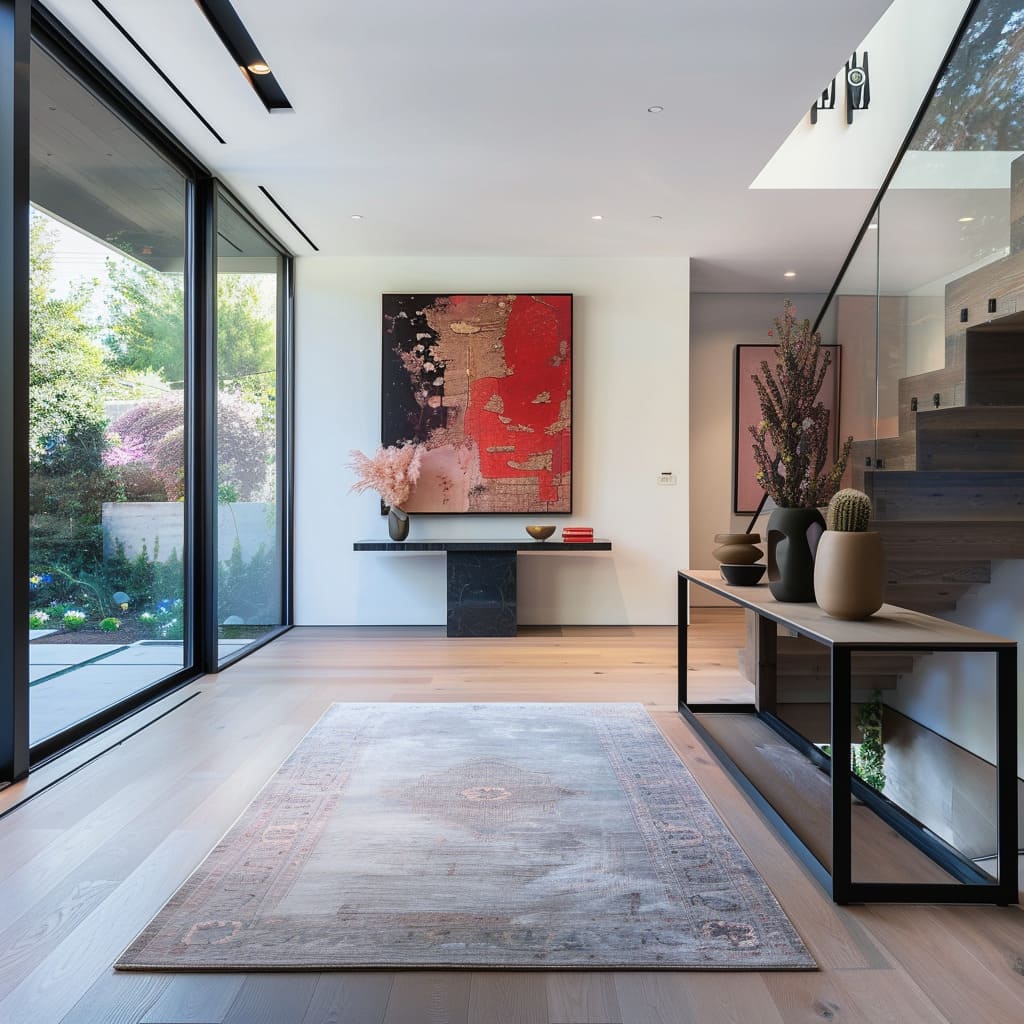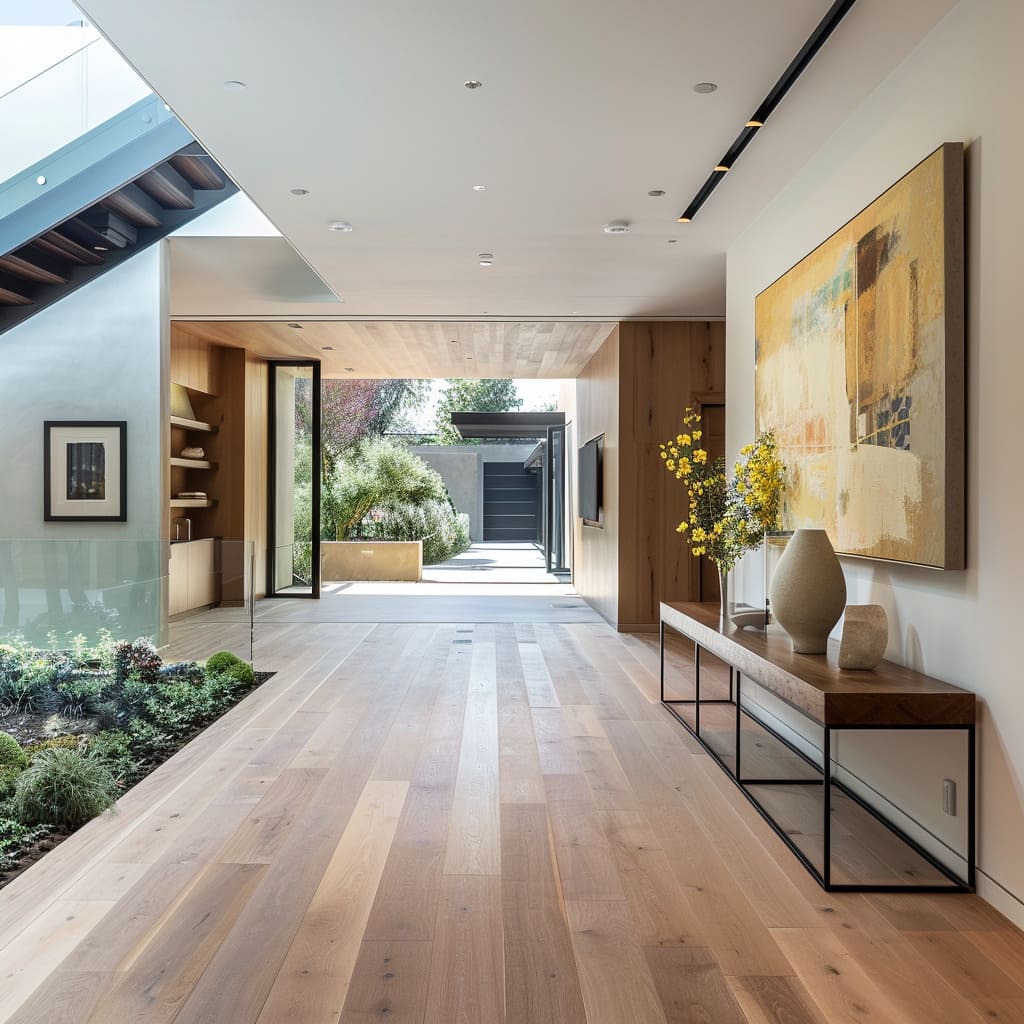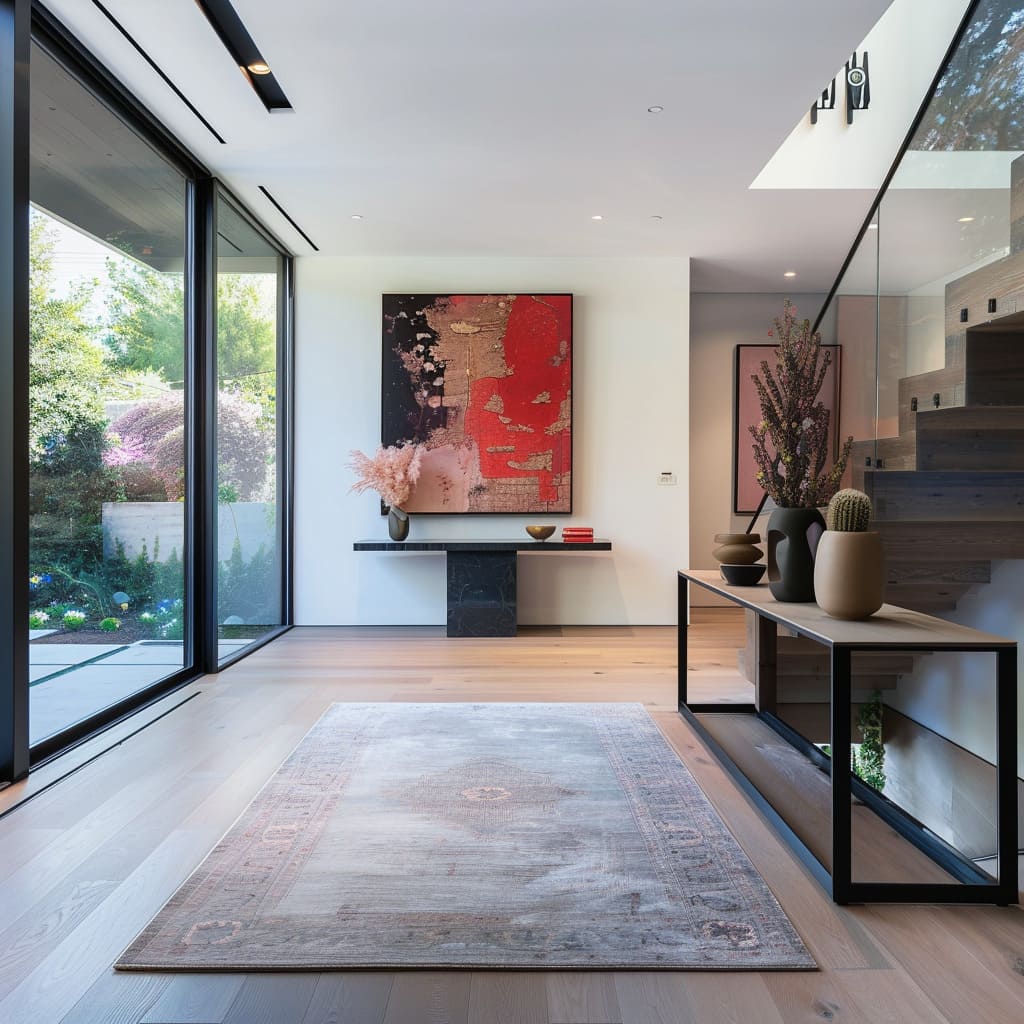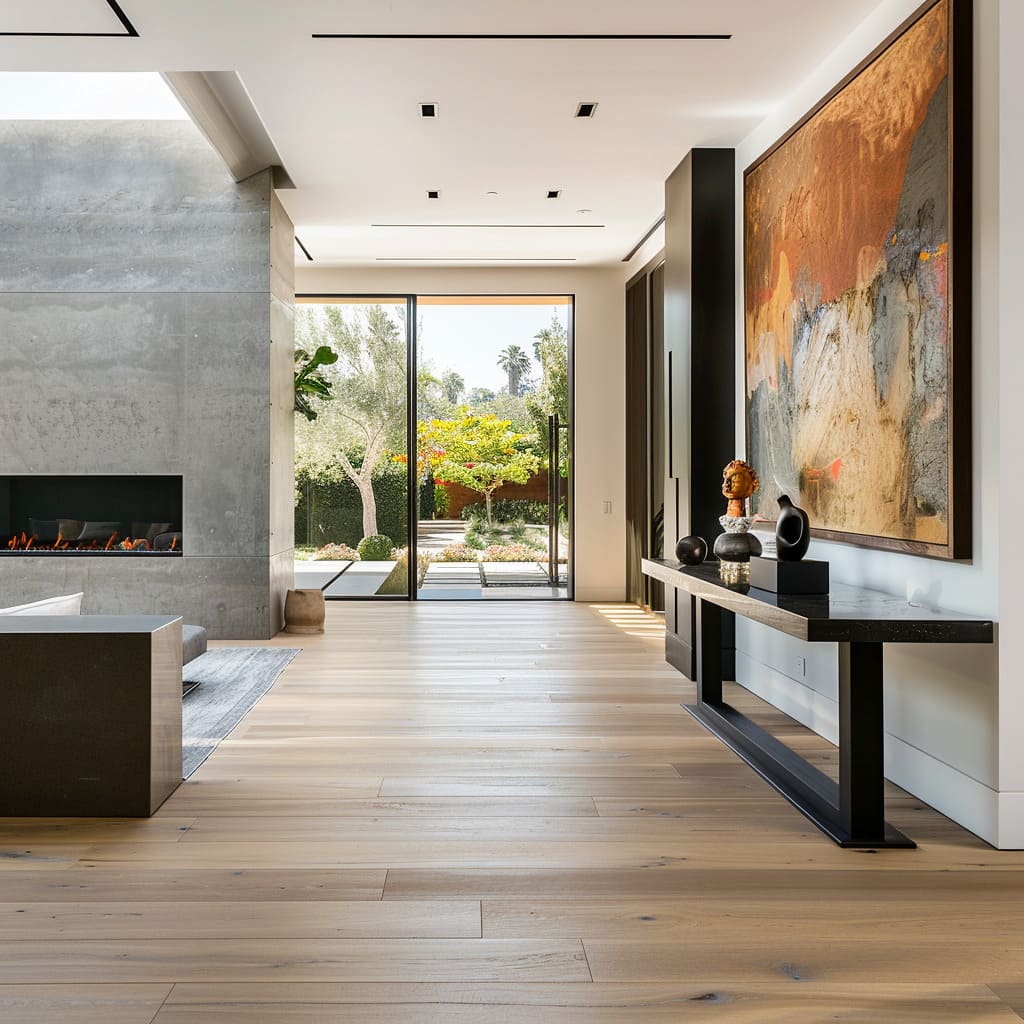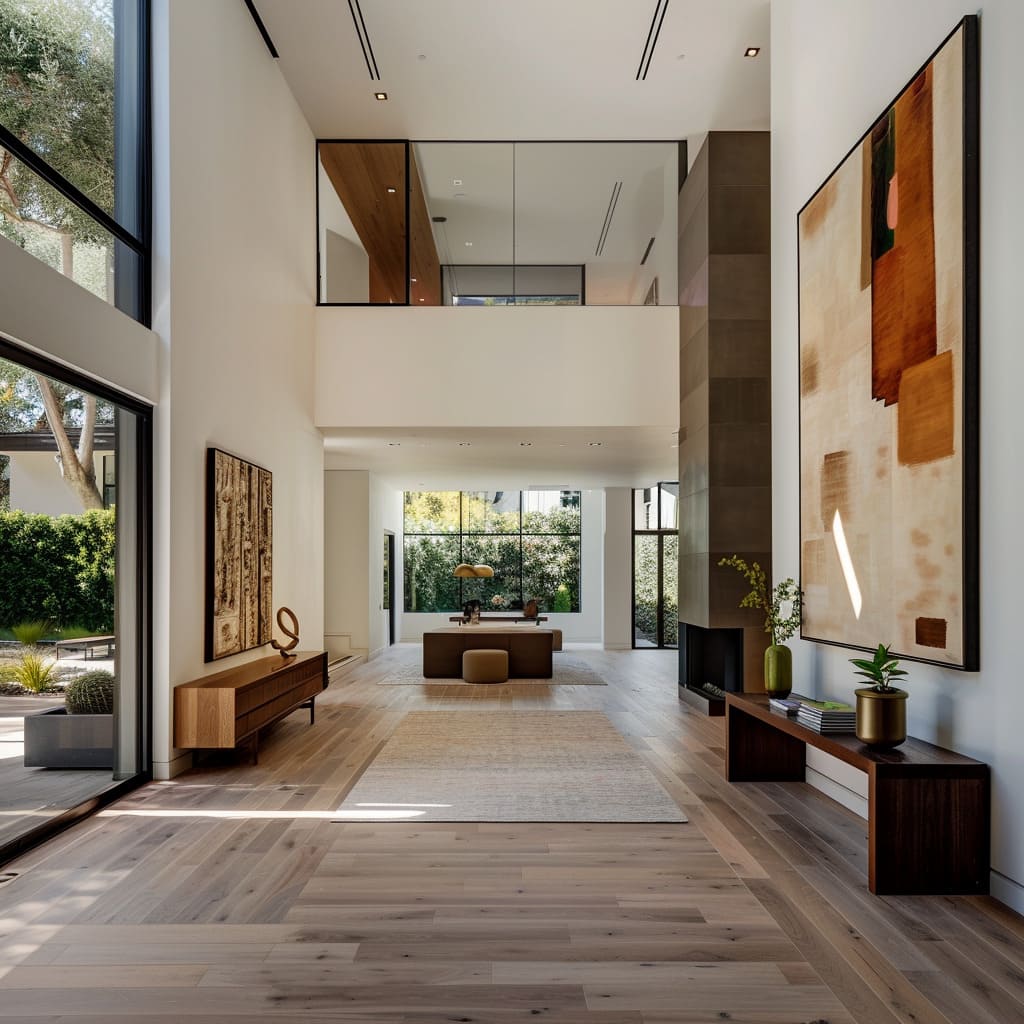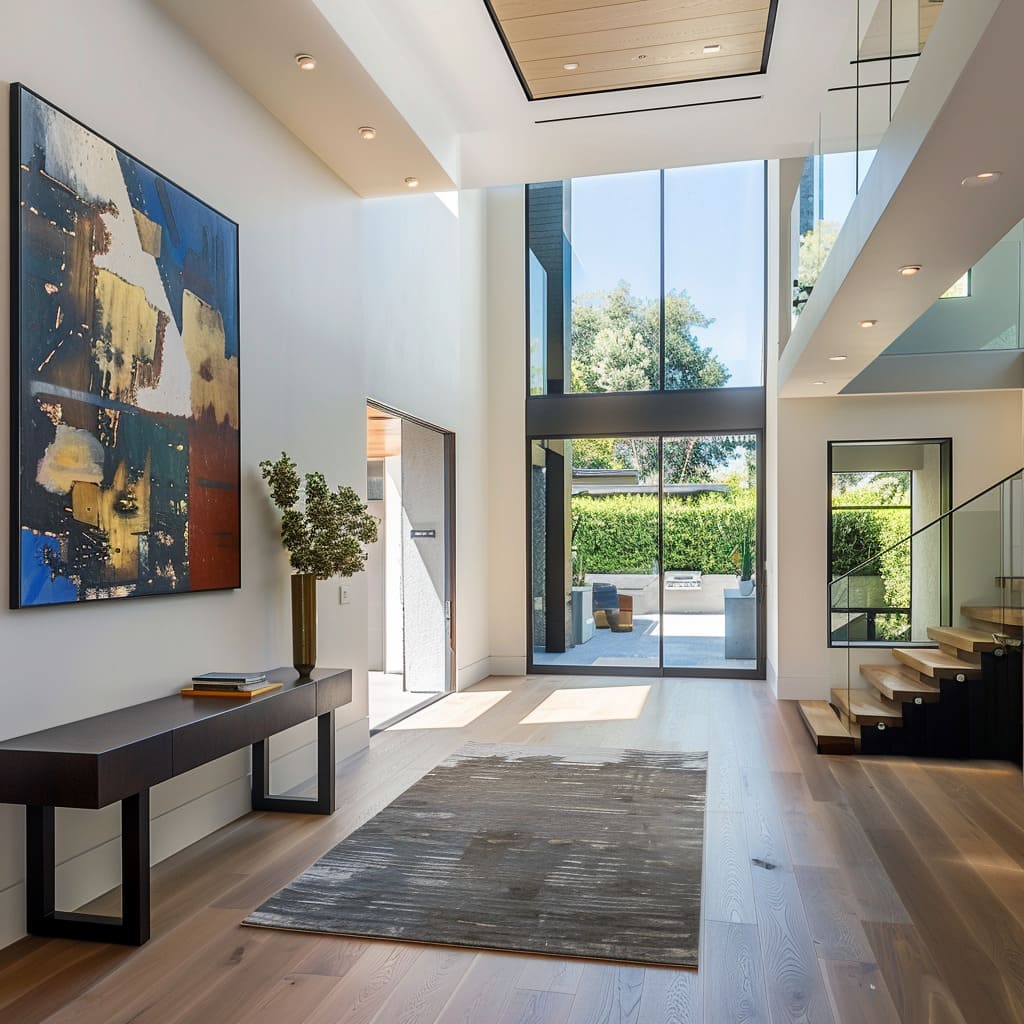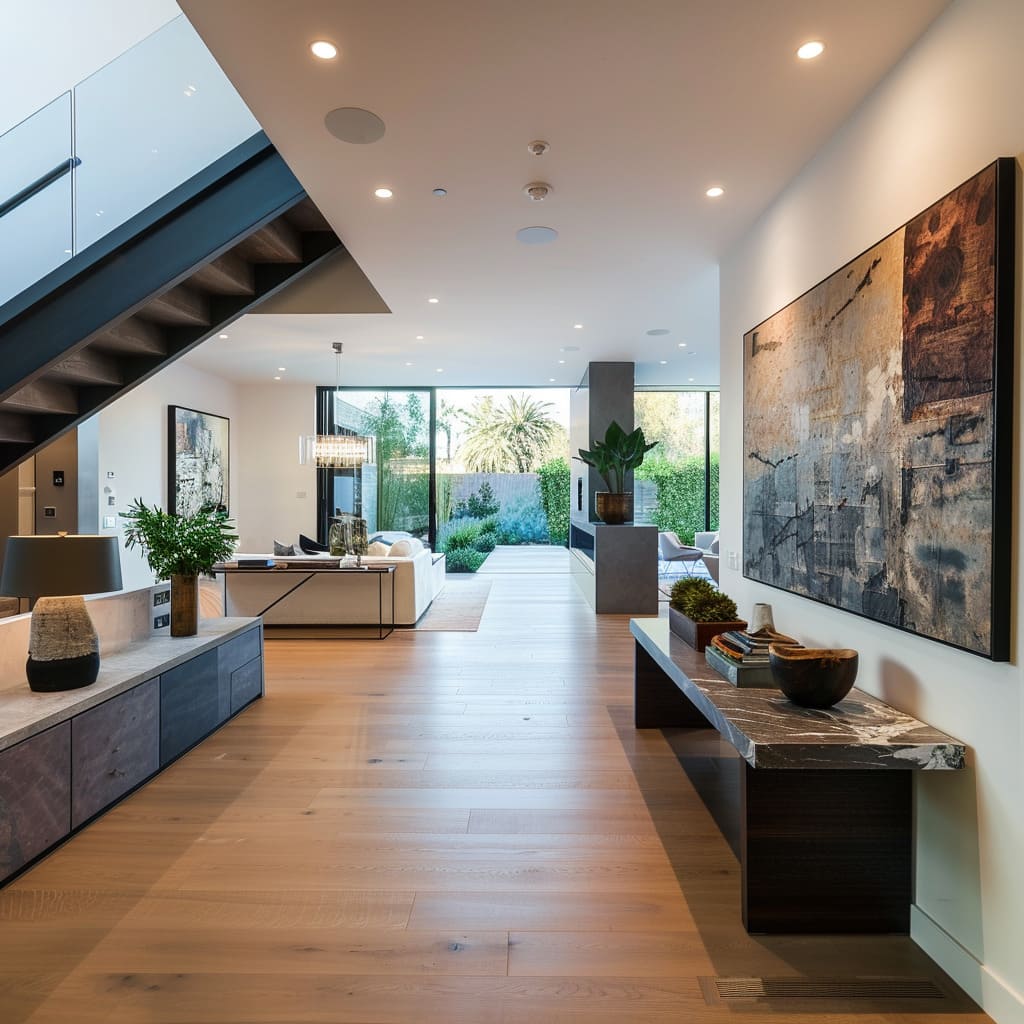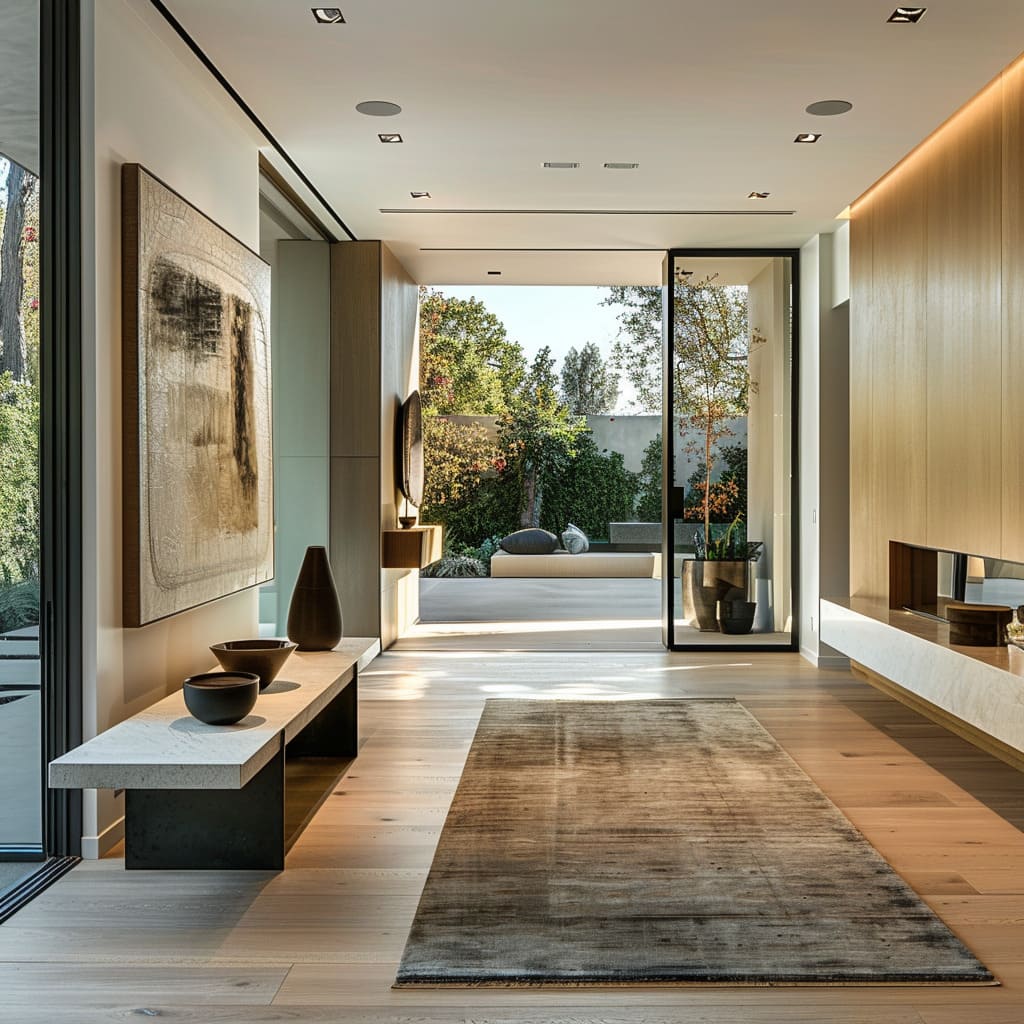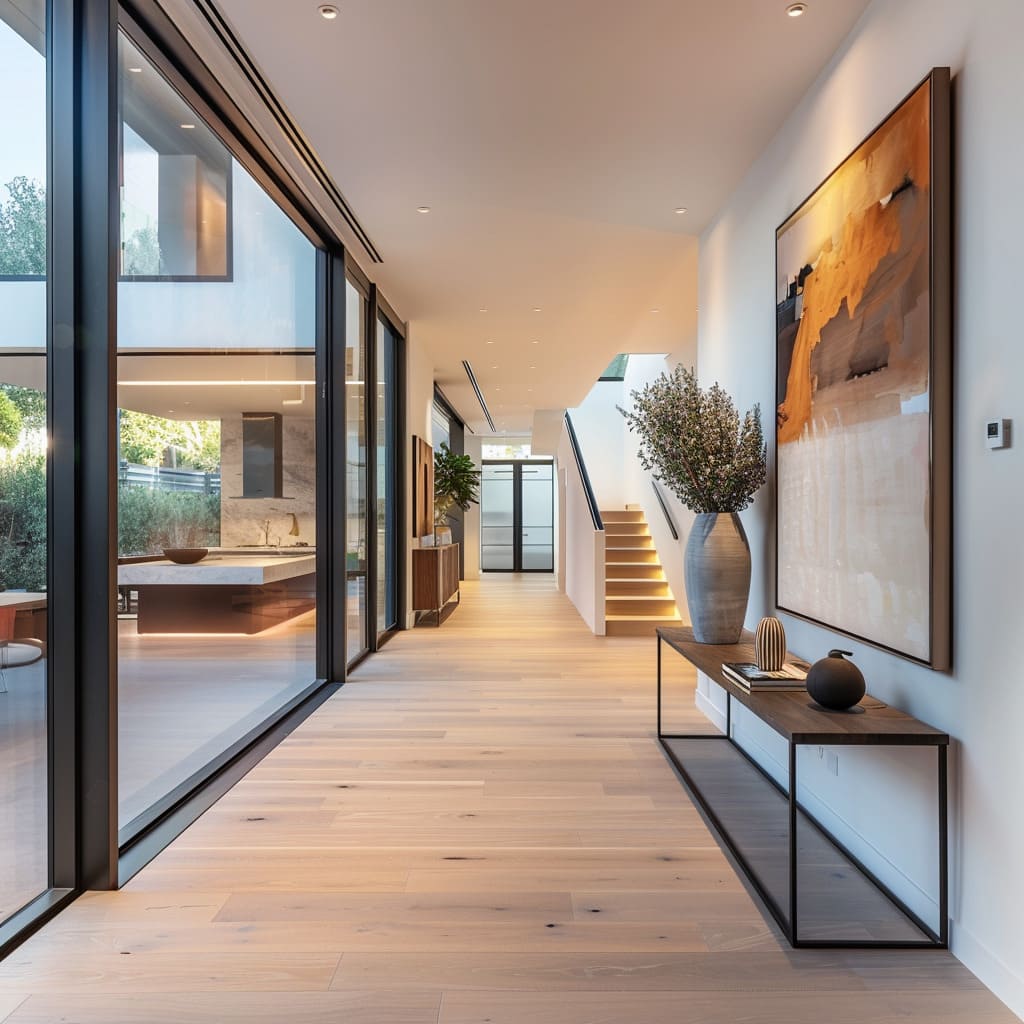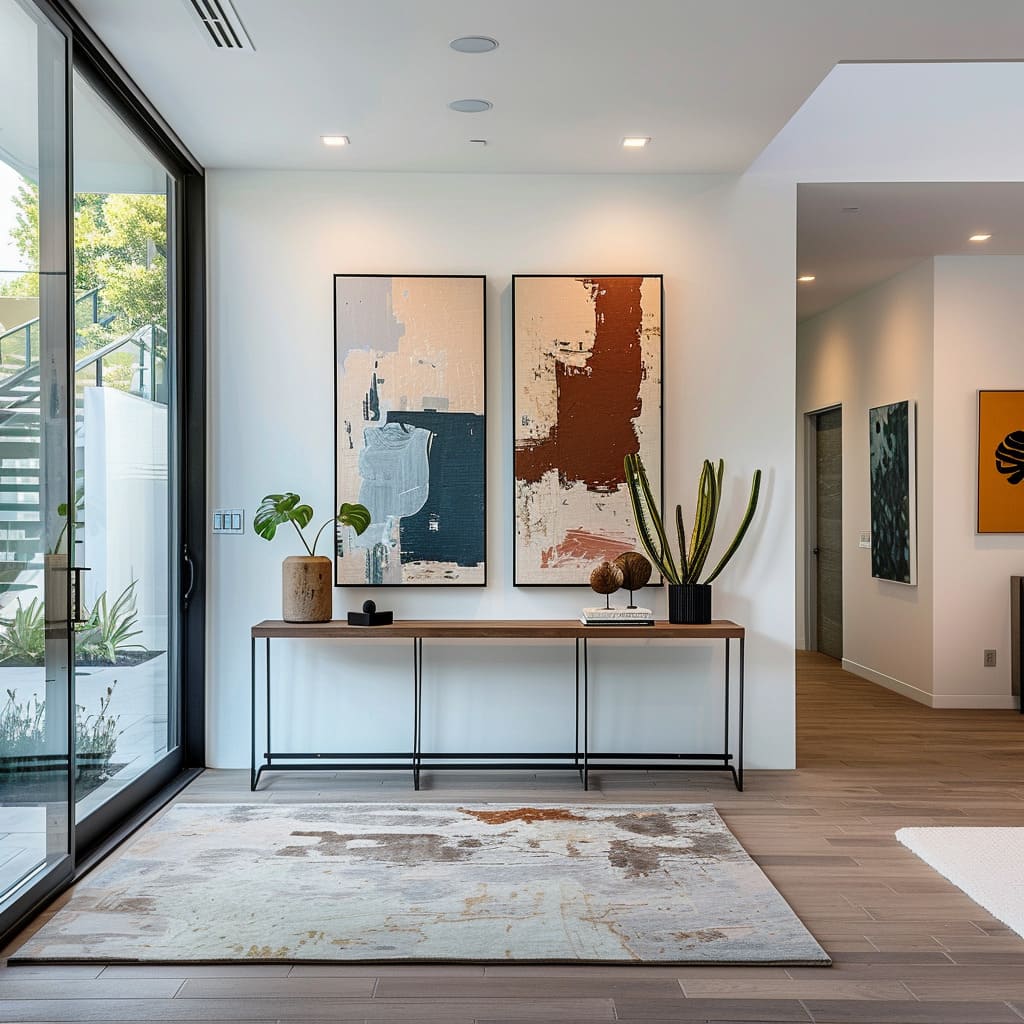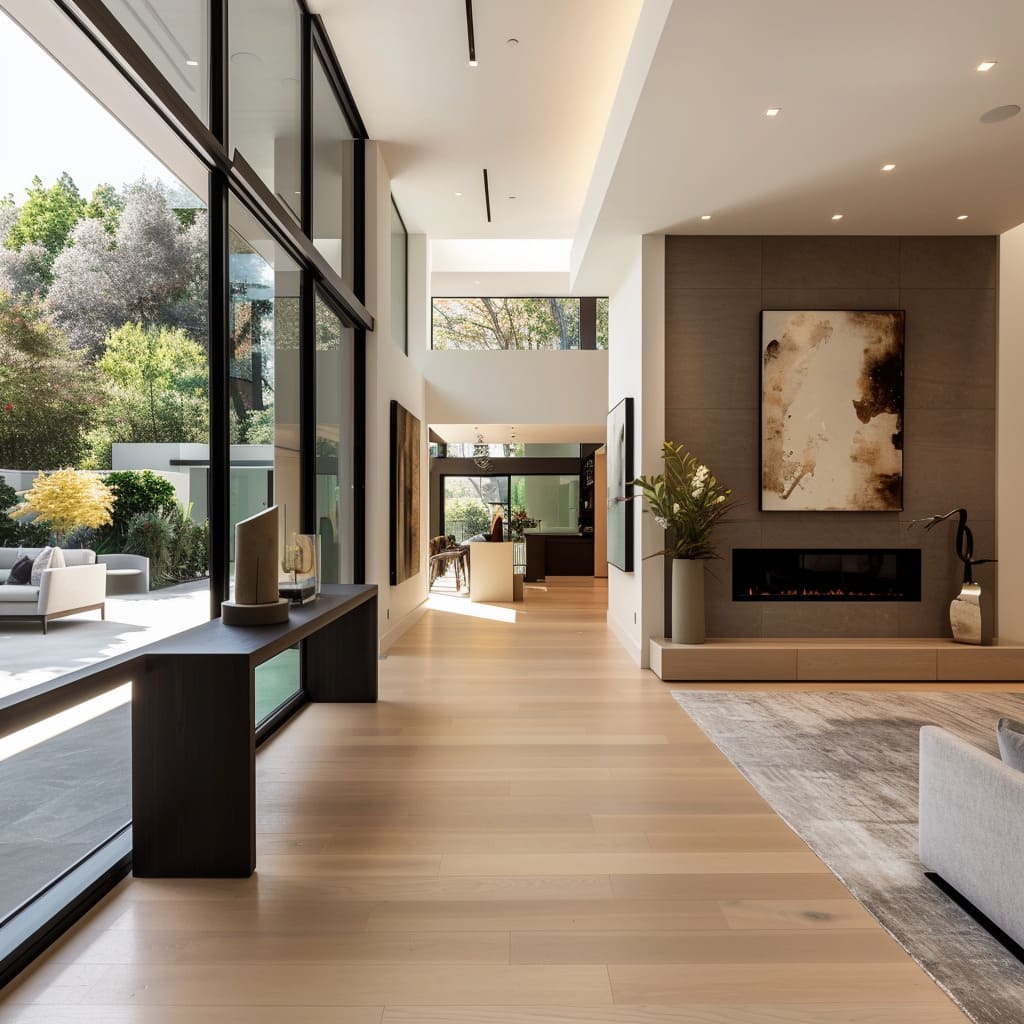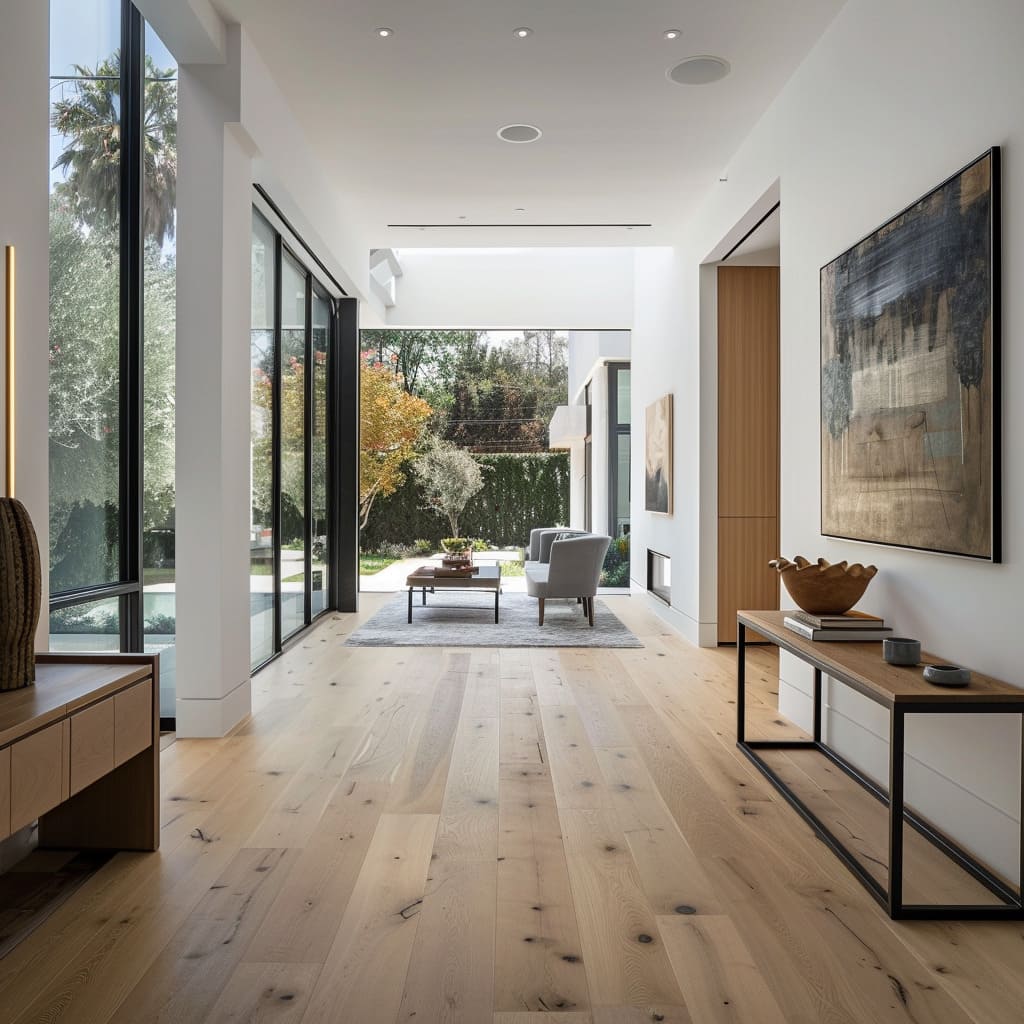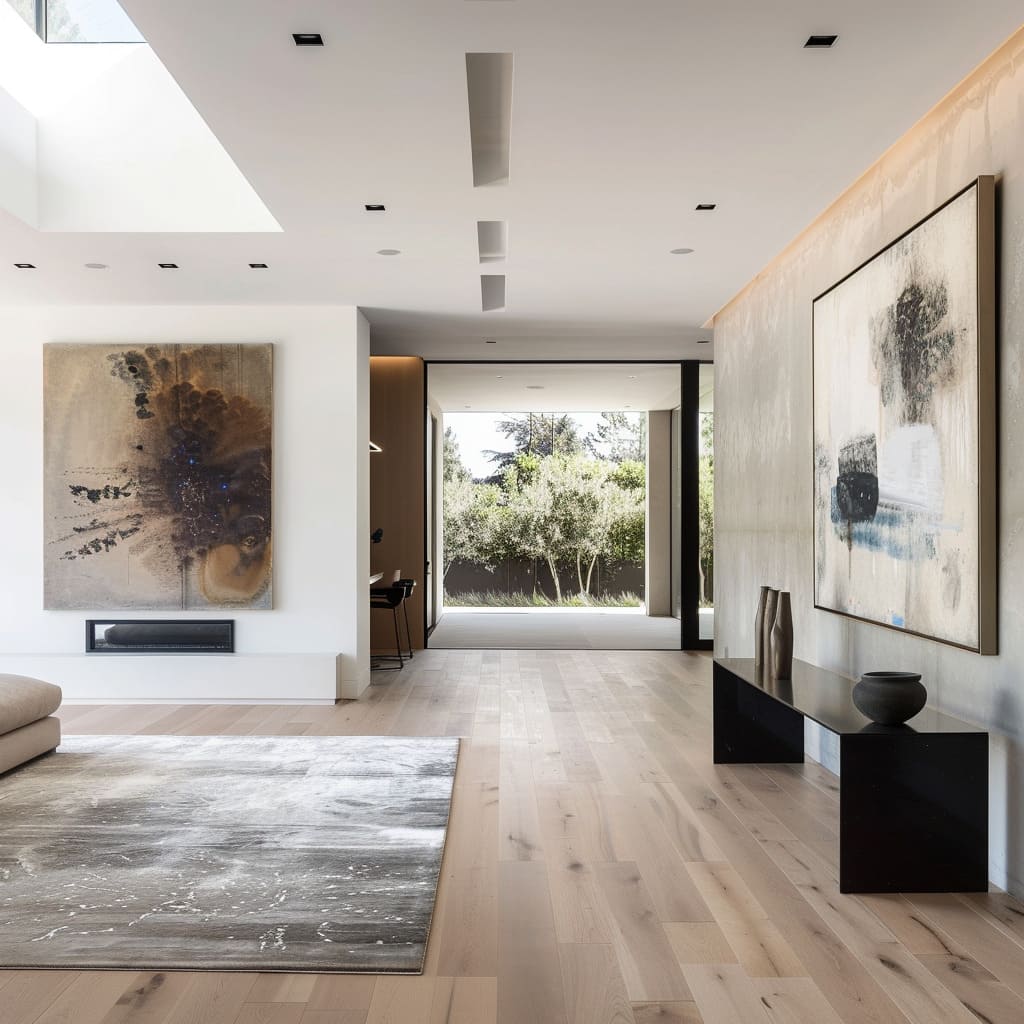The harmony of space and form stands as the cornerstone of contemporary elegance. As we delve into the world of visual and spatial dynamics, the acute understanding of how color, light, and form coalesce to shape the experience of a space becomes apparent.
The strategic orchestration of these elements is not by chance but by design, each contributing to the overarching narrative of a home that is not only seen but felt. Within the pages that follow, we explore the meticulous crafting of visual zones through color, the expansive illusion granted by glass, the delicate dance of lines, and the architectural artistry of ceilings—each an integral stroke on the canvas of modern interior design.
Visual and Spatial Dynamics
The interplay of visual components and spatial planning is essential in constructing an inviting atmosphere. The strategic application of color, transparency, and architectural constructs not only delineates but also enhances the spaces within a home.
Strategic Use of Color for Visual Zones
Colors are selected with forethought, with each hue serving a specific purpose. Beyond mere ornamentation, these colors act as silent guides, leading one through the various sections of the home.
Soft transitions between shades suggest the function of each area, establishing a visual code that’s both intuitive and aesthetically pleasing.
Use of Glass to Enhance Spaciousness
Transparency is masterfully employed to dissolve the barriers between interior and exterior realms. Expansive windows and glass doors invite the gaze to wander, to extend beyond the physical confines of walls.
In areas where privacy is required, glass is strategically frosted or textured, maintaining the spacious feel while providing seclusion.
Contrast Between Vertical and Horizontal Lines
There’s a deliberate contrast in the orientation of structural components—where vertical panes of glass reach upwards, horizontal furnishings and structural beams reach across. This creates a visual cadence, akin to the silent rhythm of a musical score, where the eyes dance along lines and intersections, finding rest in the open spaces.
Modulation of Ceiling Planes: The ceilings themselves are canvases for design, with recessed lighting fixtures and varying levels that offer a third dimension to the choreography of the home’s structure. Where a ceiling dips, intimacy is fostered; where it rises, the mind is given room to soar.
Light plays off these surfaces, changing with the time of day, adding to the dynamic nature of the space.
Design Elements as Focal Points
The calculated placement and selection of design elements are instrumental in anchoring the visual experience of a space. These elements attract the gaze, imparting both direction and visual pleasure within the home’s layout.
Precision in Architectural Symmetry
The calculated arrangement of openings and furnishings is a testament to the thoughtful design, which introduces a sense of tranquility through balance. This symmetry extends beyond mere alignment, as it is also echoed in the proportional relationship between the furnishings and the room sizes.
Even the artwork aligns with this concept, being centered with precision to act as visual anchors that draw the room together.
Inclusion of Unique Art Pieces
Art becomes more than decoration; it is the soul of the space, imbuing each room with a distinct persona. The selection of artwork is deliberate, each piece conversing with its surroundings, not merely occupying space but enhancing the environment.
The scale of these pieces is bold, ensuring their role as central characters in the design narrative.
Selective Visibility of Structural Elements
Exposed columns are not hidden but celebrated, painted in hues that complement the room’s palette while still standing out as points of interest.
The choice of materials for these features—sometimes wood, other times metal or concrete—is intentional, providing textural contrast and a touch of raw authenticity.
Grounding and Complementing Details
In the realm of interior design, the elements that provide a foundation to the living space are as vital as the overarching concept. It’s the textiles, the accessories, and the custom features that inject warmth and purpose, transforming a house into a home.
Strategic Placement of Rugs
The rugs are thoughtfully positioned, not only to delineate spaces within an open floor plan but to also provide a textural contrast to the sleek hardwood flooring. Their borders align with key pieces of furniture, anchoring seating arrangements and creating intimate islands of relaxation.
The hues and patterns of these rugs are carefully selected to resonate with the larger color scheme, subtly reinforcing the designated functions of each area.
Careful Curation of Accessories
The selection of accessories is an exercise in restraint and intention. Each piece, be it a vase, a sculpture, or a stack of books, is chosen to complement and enhance the space.
These accessories are placed with consideration, often forming geometric arrangements or mirroring the lines of the surrounding architecture, reinforcing the room’s visual coherence.
Custom-designed Functional Features
Not merely for decoration, every built-in feature is there for a reason, from the shelving that houses a library of treasures to the benches that offer a place to pause. These elements are tailored to fit the dimensions and style of their surroundings, ensuring they perform their roles without disrupting the visual harmony of the space.
Harmonizing Flow and Function
This concluding section delves into how a uniform approach and meticulous placement of design elements contribute to an uninterrupted and coherent experience within the living space, focusing on the ease of movement and the pragmatic utilization of the area.
Consistency in Flooring for Fluidity
A continuous visual linearity is maintained with uniform flooring that guides residents and visitors alike through the space. This consistent element acts as a silent narrator, directing the flow from room to room, its gentle hues and grain providing subtle visual cues to signal transitions in function or atmosphere.
In areas of congregation, wider planks may subtly signal an invitation to linger, while narrower boards in passageways gently encourage passage.
Emphasis on Indoor Airiness
The interior is intentionally voluminous, with high ceilings creating a liberating vertical dimension that offers a sense of freedom and expansion. Furniture is deliberately spaced, allowing for an unobstructed promenade through the living areas.
This strategic arrangement is not only visually pleasing but also psychologically uplifting, providing a feeling of relaxation and openness that is often sought after in residential design. Lighting plays a critical role in this sense of spaciousness, with a combination of recessed and hanging fixtures that illuminate without encroaching on the vertical expanse.
Natural light is harnessed to its full advantage, with windows placed to catch the light at various times of the day, thus altering the room’s mood with the passing hours.
Through these methods, the design establishes not just a house, but a living, breathing space that responds to the rhythms of daily life, ensuring comfort without sacrificing visual appeal.
As we reach the end of our exploration, the true essence of contemporary interior design emerges—not merely as an assortment of design elements, but as a symphony of space, form, and function. The consistency of flooring underpins the narrative of movement, leading one through a sequence of meticulously curated experiences.
The strategic placement of rugs, the selective curation of accessories, and the custom features all play their part in grounding the design, ensuring that each detail contributes to the collective whole. Above all, the emphasis on openness and light ensures that the space remains a testament to the virtues of modern design: freedom, clarity, and the seamless interplay between the interior and the rhythms of daily life.
It is within these walls that we find not just a living space, but a dynamic environment that adapts, inspires, and evolves with the lives it envelops. This is not just design; it is the blueprint for modern living—a space crafted not only for today but for the many tomorrows to come.

